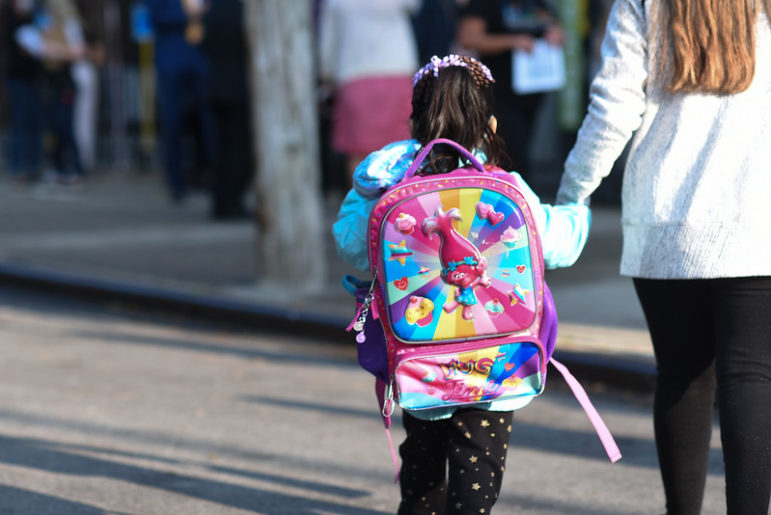‘New York State could receive $23 billion as part of the ARPA, representing a once-in-a-lifetime financial base to significantly reduce childhood homelessness, a condition that often sets up the cycle for homelessness as an adult.’

Michael Appleton/Mayoral Photography Office
A scene from the first day of school in NYC.Child homelessness is one of the greatest social ills of our time. But the recent passage of the American Rescue Plan Act (ARPA) should be celebrated as a progressive step forward for children and families across the nation—it’s estimated that child poverty may be cut in half by measures in the package.
This is a clarion call to our next mayor: seize this landmark opportunity to eradicate child homelessness in New York City.
Recent data shows that even though the number of families with children living in shelters is declining, families still currently represent over 60 percent of New York City’s homeless population. Today there are over 17,000 children sleeping in shelters, and hundreds of babies are born into homelessness every year. New York State could receive $23 billion as part of the ARPA, representing a once-in-a-lifetime financial base to significantly reduce childhood homelessness, a condition that often sets up the cycle for homelessness as an adult.
As leaders at RiseBoro Community Partnership and Power of Two, two New York City nonprofits providing critical social services, we often serve women who have delivered babies while living in shelter. Since our organizations’ work intersects with the needs of homeless families, we have witnessed the anger, frustration, mental anguish, and hopelessness that families feel as a result of their situation and the limited support they receive from the shelter system.
It is well documented that housing instability threatens a child’s well-being and can hinder their ability to succeed in school and throughout the course of their life. They experience toxic stress—exposure to adverse experiences over a prolonged period of time—making children experiencing homelessness twice as likely than their peers who are in stable housing to suffer from mental health issues like anxiety and depression. One deeply disturbing statistic shows that children experiencing homelessness are three times as likely to have suicidal thoughts and attempt suicide.
Another figure the incoming mayor can’t ignore: 90 percent of families living in shelters are either Black or Latinx. These infuriating statistics indicate that the housing and economic mobility policies in this city are designed to exclude people of color.
But it’s not too late to correct course. Now is the time to think innovatively about sustainable solutions. Preventing child homelessness requires addressing many of the inequities and underlying structural issues that perpetuate homelessness in New York. First, housing vouchers are effective at helping homeless families return and stay in the community, but many City-FHEPS voucher holders are still homeless, because the rent limits are too low when compared with market prices. The city must increase its funding of housing vouchers to meet the current market prices and give real weight to a historically proven tool in the fight against homelessness.
Next, taking steps toward eradicating child homelessness requires a coordinated approach where our city’s existing agencies—the NYC Department of Homeless Services and NYC Department of Housing, Preservation and Development—invest in evaluating their structures, policies and practices through an anti-racist lens and collaborate with other city agencies like the Department of Health and Mental Hygiene and the Department of Education. Together they can provide holistic support to families living in unstable housing or shelters. Too often, families need to have already lost their homes in order to access the help that can lift them out of the shelter system.
Incorporating a key strategy the city learned in combating Veteran homelessness, we need the next mayor and administration to prioritize federally funded grants for nonprofits specifically working to prevent child homelessness. It would be especially valuable in creating a vital safety net that helps families access the support they need to address trauma and stay in their homes.
The city also employed a coordinated effort that included a very targeted approach to accurate counting of homeless veterans and worked with organizations on individual cases to make sure that all households were being helped. Further, they created a “situation room” that met consistently with all parties addressing veteran homelessness and referred to each veteran by name when asking those organizations for specific, individualized updates on their housing procurement progress.
The same level of attention and care to homeless veterans should be applied to solving child homelessness in the city.
Shelter stays, especially for young children, should be rare and brief. Our new mayor will have many challenges but must show real and unprecedented commitment to strengthening homelessness prevention for children. The person who wins the mantle of leadership for our city has within their grasp the legacy of building opportunity to change the trajectory of the lives of thousands of children. This is the moment history and the ARPA offers and the moment that justice and social equity demands. Our new mayor must not fail a new generation of children.
Erasma Beras-Monticciolo is executive director at Power of Two and Mirtha Santana is chief program officer at RiseBoro Community Partnership.








